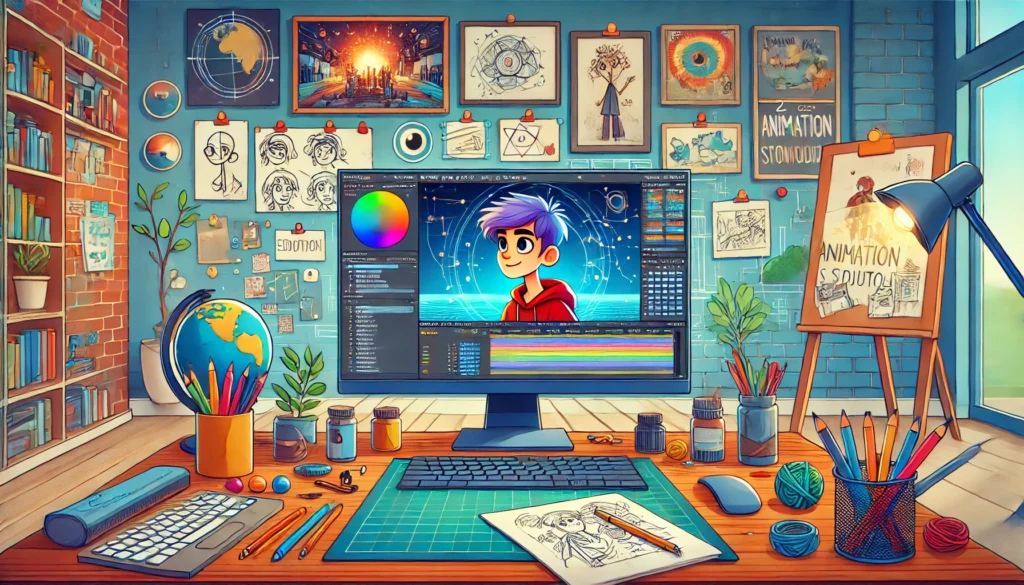
2D animation has been a significant part of the entertainment industry for over a century, and its evolution has shaped how we experience stories, characters, and visuals today. From its humble beginnings as hand-drawn sketches to its current use in digital mediums, 2D animation has undergone immense transformations. This article explores the journey of 2D animation from the past to the present and looks forward to its future in the ever-evolving digital landscape.
- The Early Years: Hand-Drawn Animation
The roots of 2D animation can be traced back to the early 20th century when animators began experimenting with movement through hand-drawn frames. The process was painstakingly slow, with each frame being drawn by hand on paper or celuloid sheets and then photographed to create a sequence of images.
The Birth of Animation
One of the earliest pioneers of 2D animation was Walt Disney, who, along with his team, created Steamboat Willie in 1928. This was one of the first animations to feature synchronized sound, and it introduced the world to Mickey Mouse, the iconic character that would become a symbol of Disney’s animation empire. Early animation was limited by the technology available, but it laid the foundation for the animation industry we know today.
Innovations and Expansion
In the 1930s and 1940s, 2D animation continued to grow, particularly in Hollywood. Disney’s Snow White and the Seven Dwarfs (1937), the first full-length animated feature film, marked a milestone in the development of animation. Throughout the 1940s and 1950s, animated series such as Tom and Jerry and Looney Tunes became popular, pushing the boundaries of what could be achieved with hand-drawn techniques.
- The Digital Revolution: The Shift to Computer-Generated Animation
By the late 20th century, the animation industry began to embrace digital technologies, which revolutionized the production of 2D animation. Traditional hand-drawn techniques were supplemented, and in some cases replaced, by computer software that allowed for faster and more efficient production.
The Rise of Digital Tools
In the 1980s and 1990s, the introduction of digital animation software like Adobe Illustrator and Toon Boom changed the landscape of 2D animation. These programs allowed animators to create and manipulate digital drawings more easily, giving them the ability to experiment with different styles, colors, and textures.
Hybrid Animation
One of the significant shifts in 2D animation was the use of hybrid animation, where traditional hand-drawn techniques were combined with computer-generated elements. This was seen in films such as The Lion King (1994), which blended traditional 2D animation with computer-generated backgrounds, creating a richer visual experience.
Rise of Digital Platforms
The 1990s and early 2000s saw the emergence of platforms such as Flash animation, which allowed for quicker production times and easier distribution of animated content online. Animated web series and cartoons began to thrive, leading to the creation of iconic series such as The Simpsons and South Park, which utilized digital animation techniques.
- The Present: 2D Animation in the Digital Age
In today’s digital age, 2D animation is a thriving art form used in various sectors, from feature films and TV shows to social media content and advertising. The evolution of digital tools has enabled animators to create highly detailed and polished animations with greater efficiency.
High-Quality 2D Animation
Advancements in digital animation software, including programs like Toon Boom Harmony and TVPaint, have made it possible to create 2D animations that rival traditional hand-drawn works in quality and precision. These tools allow animators to create more fluid and lifelike movements, improving the overall visual appeal of the animation.
The Resurgence of Traditional Styles
Despite the rise of 3D animation, traditional 2D animation has experienced a resurgence, with animated films like The Princess and the Frog (2009) and The Secret of Kells (2009) bringing back the hand-drawn aesthetic. Streaming platforms like Netflix have also embraced 2D animation, with original shows such as BoJack Horseman and Castlevania receiving widespread acclaim for their unique art styles.
2D Animation in Digital Content
With the rise of social media and digital content creation, 2D animation has found a new purpose in the creation of short-form videos, educational content, and viral marketing campaigns. Platforms like Instagram, TikTok, and YouTube have seen a surge in 2D animated content, allowing creators to share their work with a global audience.
- The Future: Where is 2D Animation Heading?
The future of 2D animation looks promising, as technology continues to evolve and new tools emerge that push the boundaries of creativity. As animation becomes more integrated with other forms of digital media, new opportunities will arise for animators and content creators.
Integration with Augmented Reality (AR) and Virtual Reality (VR)
One of the most exciting prospects for 2D animation is its integration with emerging technologies like AR and VR. As AR and VR platforms become more widespread, 2D animation can be used to create interactive and immersive experiences, such as animated characters appearing in real-world environments or virtual worlds that come to life through animation.
AI-Assisted Animation
The development of artificial intelligence (AI) could also revolutionize the animation industry. AI-powered tools could automate parts of the animation process, such as in-betweening (the creation of intermediate frames between key poses) or generating backgrounds, making production faster and more cost-effective. This would allow animators to focus more on the creative aspects of their work while AI handles the repetitive tasks.
New Media Platforms
The growing popularity of interactive media, gaming, and immersive experiences means that 2D animation will continue to evolve and adapt. New forms of storytelling, such as interactive animated series or animated video games, will offer audiences fresh and exciting ways to engage with animated content.

